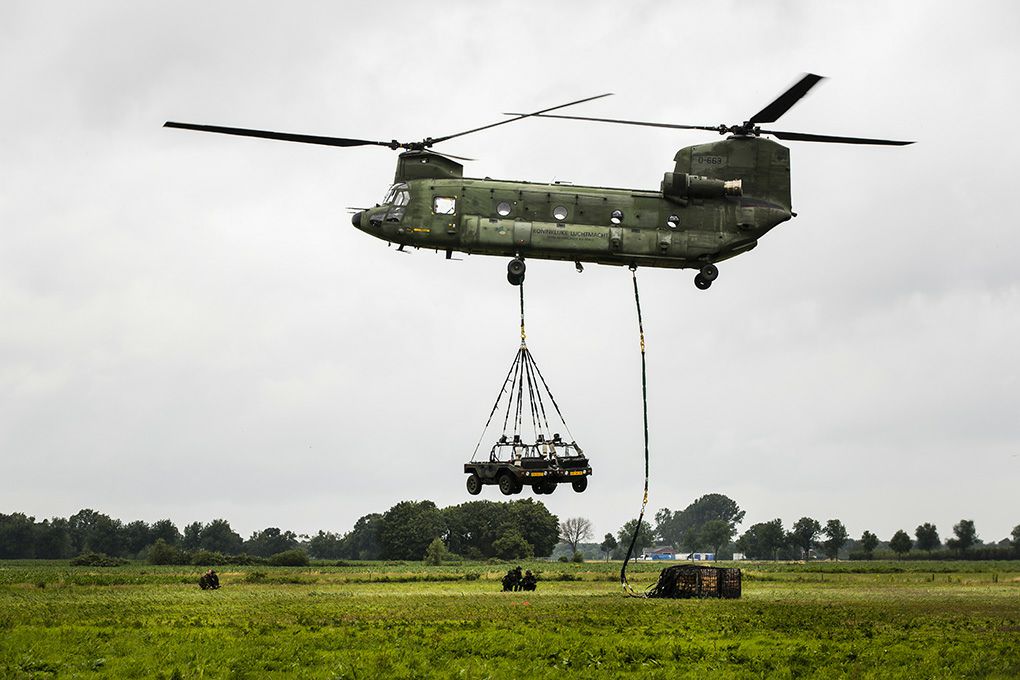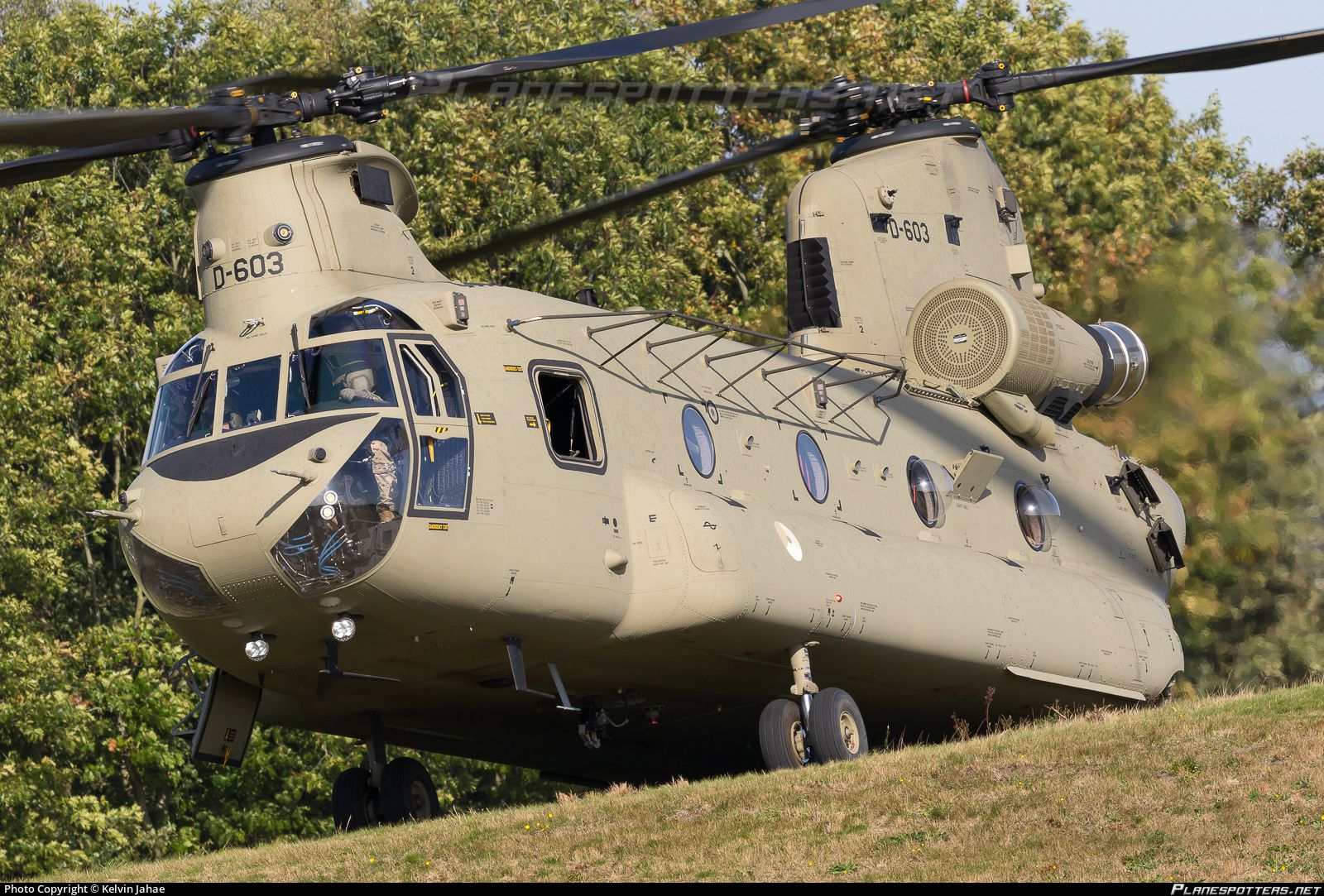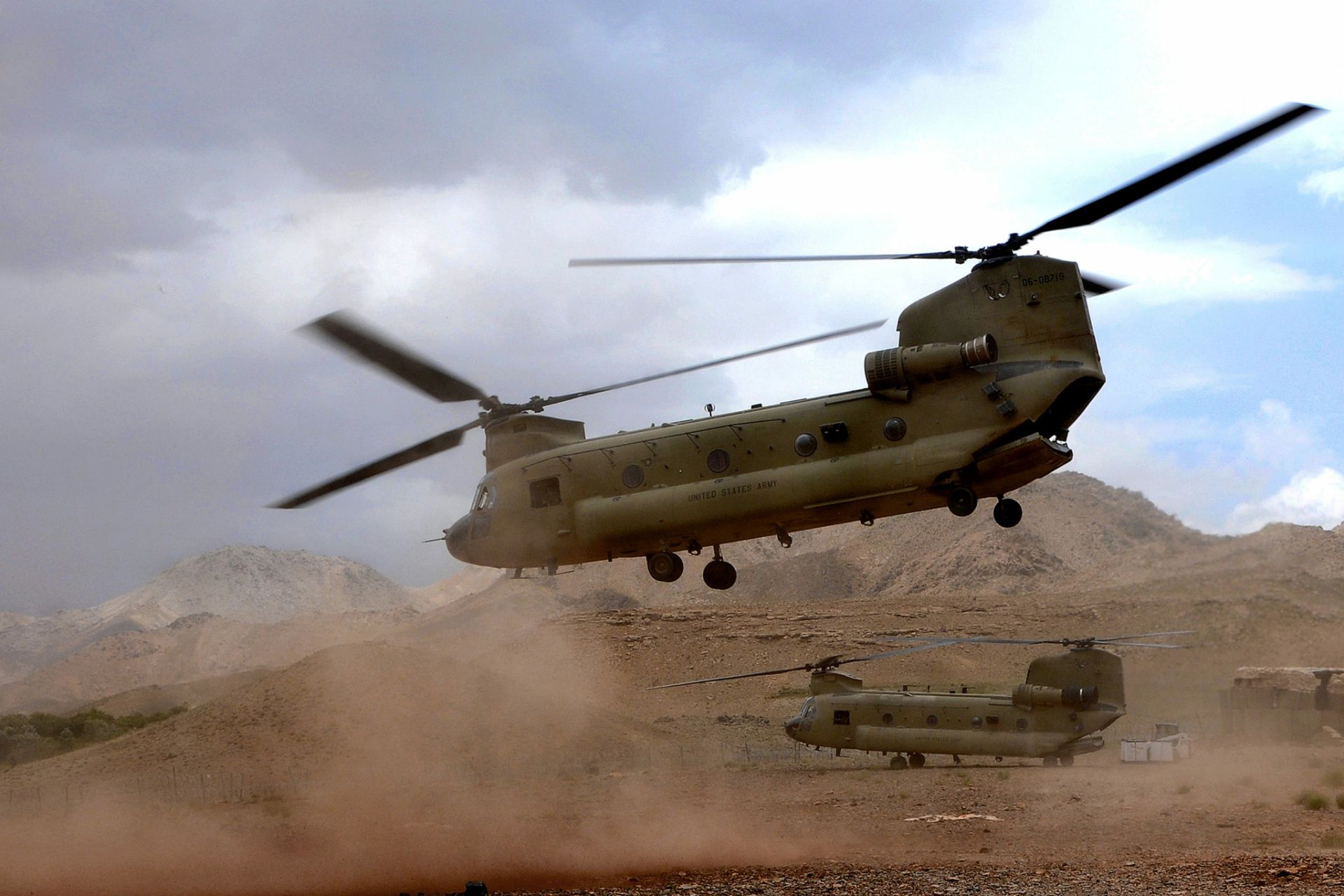In the latest November saga of Bravo magazine, a British Chinook helicopter defied its fate and refused to go down. Different crews flying this battle-hardened Royal Air Force Chinook have won four Distinguished Flying Crosses between them.
As the British Royal Air Force and manufacturer Boeing celebrate 40 years of the CH-47 Chinook heavy-lift helicopter in UK service, one of the very first of these rotorcraft that the country received is still flying operationally today and has an incredible story to tell. This Chinook, known as “Bravo November,” narrowly avoided destruction more than once during the 1982 Falklands war. Since then, no fewer than four of its pilots have been awarded the Distinguished Flying Cross on different operational missions.

Bravo November was among the initial batch of 30 Chinook HC1s ordered by the Royal Air Force (RAF) in 1978, the first of which arrived in the United Kingdom on November 22, 1980. Yesterday, the RAF, Boeing, and assorted squadrons and individuals associated with the heavy-lift workhorse over the years that have followed marked the 40th anniversary of this delivery.
The Chinook remains the backbone of rotary heavy lift from its first operational deployment to the Falklands, to its current deployment in Mali, delivering a capability second to none.
27 Squadron joined the #ChinookForce in Jan ’98, and we are proud to have formed a big part in this incredible aircraft’s history.

Boeing Defense’s CH-47 also hits 60 next year!.
Today marks the 40th anniversary of the CH47 Chinook helicopter in service with the Royal Air Force. Along with our predecessors JHSU, we have been on that journey almost since the beginning. Here’s to the next 40! Keep on hooking!.
Happy 40th anniversary to the Chinook – it’s been our ride of choice for moving soldiers and equipment around the battlefield since entering Royal Air Force service on 22 Nov 1980.
The Bravo November name was derived from the helicopter’s two-letter code, “BN,” though it was formally known as ZA718, according to the British military serial number system.

When Argentina invaded the Falklands Islands, a British overseas territory in the South Atlantic, on April 2, 1982, Bravo November was assigned to No. 18 Squadron, the RAF’s only Chinook operator at the time, based at RAF Odiham, Hampshire, in southwest England.
Four days later, No. 18 Squadron was called into action in support of Operation Corporate, the British military action to retake the Falklands. Five of the unit’s Chinooks were then flown to the port of Plymouth, where they were loaded aboard the container vessel Atlantic Conveyor, which had been requisitioned by the U.K. Ministry of Defence at the beginning of the conflict. The Atlantic Conveyor arrived at Ascension Island, the British task force’s staging post in the South Atlantic Ocean, on May 5.
One of the Chinooks remained on Ascension Island, where it was used to shuttle stores between the island and various ships involved in the campaign. The other four heavy-lift helicopters remained on the deck of the Atlantic Conveyor, which continued toward the war zone. The ship’s other aircraft cargo comprised eight Sea Harrier fighter jets, six Harrier GR3 ground-attack jets, and another seven helicopters, a mixture of Lynx and Wessex types.

On May 18, the container vessel met up with the British task force, and the Sea Harriers and Harriers took off to join the aircraft carriers involved in Operation Corporate, the official nickname for the British response to the Argentinian invasion. Meanwhile, it was planned that the helicopters would be delivered directly to the Falklands.
Before the Chinooks could take off from the Atlantic Conveyor and head to the Falklands, the ground crew faced the tricky job of refitting the rotor blades, each weighing around 300 pounds and 30 feet long. Reinstalling the blades required raising them into position with a forklift, but then the ground crew had to lock them into place. As the ship’s deck pitched in the rough sea, the blades flexed, and this, combined with the jerking movements of the forklift, nearly resulted in the loss of several fingers.
Finally, with rotor blades in place and engines tested, the Chinooks were ready to go, and Bravo November was the first to launch, on the afternoon of May 25.

Soon after Bravo November had departed the Atlantic Conveyor on its test flight, a pair of Exocet anti-ship missiles launched by Argentine Navy Super Etendard fighter jets hurtled toward the vessel at wave-top height, slamming into its port side. The ship was rapidly set ablaze, and 12 crew were killed. The vessel was left to burn out, a process aided by the stocks of ammunition stored below decks. Six Wessex, three Chinooks, and a Lynx were all destroyed in the process.
Bravo November recovered to the aircraft carrier HMS Hermes before flying to East Falkland the following day. Here, the much-reduced No. 18 Squadron detachment set up base with its single helicopter, two four-man crews, nine technicians, and 10 support personnel.
The Chinook was by far the most capable helicopter available to the British task force, its lifting capacity of 12 tons equivalent to three Sea Kings. However, all the spare parts, tools, lubricants, and manuals had been destroyed on the Atlantic Conveyor, so keeping the rotorcraft flying would be an enormous challenge. At first, the crew reckoned they would be able to sustain flying operations for a couple of days, no longer, but things turned out very differently.

“The aeroplane went on day after day with bits going unserviceable,” recalled Squadron Leader Dick Langworthy, boss of No 18 Squadron at the time. “But the engines kept going, the rotors kept turning, and she continued to do the job.”
This job at first included hauling supplies from ships positioned off the Falklands to storage areas on the islands, while Argentine prisoners captured during the battles on land were taken in the other direction. A vital role was carrying ammunition for British artillery, which involved 10-ton pallets being slung under the fuselage. More often than not, the Chinook was operated in excess of its maximum all-up weight.
Bravo November’s next close call came on the evening of May 30, during a nighttime Royal Marine raid on an Argentine position on Mount Kent, East Falkland. While three Sea Kings carried the Marines to their objective, the Chinook followed with three 105-mm guns (two in the fuselage, one underslung), plus 22 more troops. Although equipped with primitive night-vision goggles (NVGs), Bravo November was flying at low-level through snow, and the resulting whiteout made the goggles almost useless.

While the underslung gun was delivered without too much difficulty, dropping off the other two guns and the troops would require a hazardous landing. The crew had been expecting some flat ground, but instead found a sloping bog with rivers and stones on either side. On the first landing, the rear end of the Chinook sunk into the mud, and the rear ramp couldn’t be operated. The next attempt was made with the ramp already lowered, but it was a struggle to disgorge the bulky guns over the soft ground.
At this point, a firefight broke out between British and Argentine troops before the Chinook’s cabin lighting failed, plunging it into darkness. The rest of the unloading operation was conducted with handheld flashlights before the Chinook departed again into the night.
The return leg was more dangerous still, with heavy snow showers, and at one point, Bravo November descended so low that it struck a creek, skidding across the surface as water was thrown up into the engines, draining them of power. On the flight deck, the co-pilot jettisoned his door, preparing for emergency egress, while the pilot struggled with the heavy controls, the hydraulic system now being starved of power.

“We were lucky because if we had hit solid ground, we would have been dead,” reflected co-pilot Flight Lieutenant Andy Lawless after the mission. “We hit at 100 knots. The bow wave came over the cockpit window as we settled, and the engines partially flamed out. I knew we had ditched, but I was not sure if we had been hit.”
It needed the combined strength of the pilot and co-pilot on the controls to bring the Chinook clear of the water.
In the rear of the Chinook, one of the other two crewmen, Flight Lieutenant Tom Jones, had his flying helmet torn off during the impact with the water. Fearing that the helicopter was now about to break up, he was preparing to jump from the Chinook when another crewman provided a spare helmet, and Jones then discovered over the intercom that the aircraft was successfully climbing at 1,500 feet.
The slightly more battered Bravo November made a safe landing back at its Port San Carlos base. As the pilot, Squadron Leader Langworthy was later awarded the Distinguished Flying Cross (DFC) for his actions.

June 2 saw Bravo November play a crucial part in the operation to secure Fitzroy settlement, an important area of high ground on East Falkland. For this mission, no fewer than 81 paratroops, twice the normal capacity, were crammed into the helicopter, together with their weapons, and, once again, the weather was dismal. With thick, low-lying clouds, the pilots relied on ground features to find their way, but the peaks of hills were obscured. The troops were successfully delivered, and the Chinook then brought in another 75 paratroops to Fitzroy to help secure the objective.
In the days that followed, Bravo November continued to move artillery to wherever it was needed around the Falklands, sometimes flying as many as 15 sorties each day. Other cargo included damaged Sea Kings carried as underslung loads, and wounded troops — as many as 64 being evacuated in one flight on June 8.
Another mission involved an underslung load that was described as “bloody awful” by one of the pilots involved. This was an eight-ton metal bridge that swung wildly under the Chinook as soon as the aircraft had picked up speed. The pilots were forced to decelerate to around 20 knots to prevent the bridge from flailing around dangerously below their helicopter.

The bridge-lift operation took place on June 14, the same day that the Chinook detachment got the news that Argentine forces in the Falklands had surrendered.
In the course of their campaign, Bravo November had recorded over a hundred flying hours and carried some 1,500 troops, 95 casualties, 650 prisoners of war, and 550 tonnes of cargo.
Bravo November had done all that was asked of it and more in the effort to retake the Falkland Islands, and the crews were only left to wonder how much more efficient the British operation could have been had all four Chinooks made it off the Atlantic Conveyor in time.
Since 1982, Bravo November has been upgraded several times and remains in frontline service today. Most recently, it has been reworked to become a Chinook HC6A variant, broadly equivalent to the U.S. Army’s CH-47F, and which features the Boeing Digital Automatic Flight Control System (DAFCS). This latter provides pilots with improved handling and stability in challenging operational environments and increases flight safety when flying at night or in degraded visual environments — just the kinds of conditions that Bravo November battled through in the Falklands.

In the intervening years, Bravo November and the wider RAF Chinook fleet have played vital wartime roles in the 1991 Gulf War, as well as operations in Northern Ireland, the Balkans, Afghanistan, and Iraq again after the 2003 invasion. Most recently, an RAF Chinook detachment has been providing much-needed heavy-lift rotary support to the French contingent in Mali. On the home front, the Chinook has become a familiar sight working in support of civilian relief operations in the United Kingdom, including responses to flooding and the COVID-19 pandemic.
The second DFC awarded to Bravo November crew came during Operation Telic, the British military’s component of the U.S.-led invasion and subsequent occupation of Iraq beginning in 2003 when Bravo November became the first helicopter to land Royal Marines on the Al-Faw peninsula in the extreme southeast of Iraq.
In the course of their campaign, Bravo November had recorded over a hundred flying hours and carried some 1,500 troops, 95 casualties, 650 prisoners of war, and 550 tonnes of cargo.

Bravo November had done all that was asked of it and more in the effort to retake the Falkland Islands, and the crews were only left to wonder how much more efficient the British operation could have been had all four Chinooks made it off the Atlantic Conveyor in time.
Since 1982, Bravo November has been upgraded several times and remains in frontline service today. Most recently, it has been reworked to become a Chinook HC6A variant, broadly equivalent to the U.S. Army’s CH-47F, and which features the Boeing Digital Automatic Flight Control System (DAFCS). This latter provides pilots with improved handling and stability in challenging operational environments and increases flight safety when flying at night or in degraded visual environments — just the kinds of conditions that Bravo November battled through in the Falklands.
In the intervening years, Bravo November and the wider RAF Chinook fleet have played vital wartime roles in the 1991 Gulf War, as well as operations in Northern Ireland, the Balkans, Afghanistan, and Iraq again after the 2003 invasion. Most recently, an RAF Chinook detachment has been providing much-needed heavy-lift rotary support to the French contingent in Mali. On the home front, the Chinook has become a familiar sight working in support of civilian relief operations in the United Kingdom, including responses to flooding and the COVID-19 pandemic.

The second DFC awarded to Bravo November crew came during Operation Telic, the British military’s component of the U.S.-led invasion and subsequent occupation of Iraq beginning in 2003 when Bravo November became the first helicopter to land Royal Marines on the Al-Faw peninsula in the extreme southeast of Iraq.
Another two DFCs followed during Operation Herrick, the United Kingdom’s contribution to NATO-led operations in Afghanistan, these recognizing Flight Lieutenant Craig Wilson’s actions during a rescue mission in Helmand province in 2006, and Flight Lieutenant Ian Fortune, who led a casualty evacuation mission on behalf of the U.S. Marine Corps and Afghan National Army, under heavy enemy fire, in 2010. Flight Lieutenant Fortune was hit by a Taliban bullet that ricocheted onto his flying helmet as the injured soldiers were being extracted.
The RAF’s continued reliance on the Chinook is reflected in its fleet of 60 examples (eight HC5, 14 HC6, and 38 HC6A variants), making it the most numerous helicopter type in the U.K. armed Forces inventory. However, there are plans to buy yet more Chinooks, with another 14 on the U.K. Ministry of Defence’s shopping list.
The U.S. Defense Security Cooperation Agency (DSCA) announced on October 19, 2018, that US State Department approval had been granted for the sale of 16 H-47 Chinook (Extended Range) helicopters, a number that has since been trimmed back to 14, required to replace the RAF’s oldest Chinook airframes. These new rotorcraft will be in a special forces configuration similar to the U.S. Special Operations Command’s MH-47G Block II.
Once completed, the next U.K. Chinook order will likely mark the end of Bravo November’s career. There’s a high chance the airframe will be preserved, however, after which this remarkable survivor will see out a well-earned retirement.





